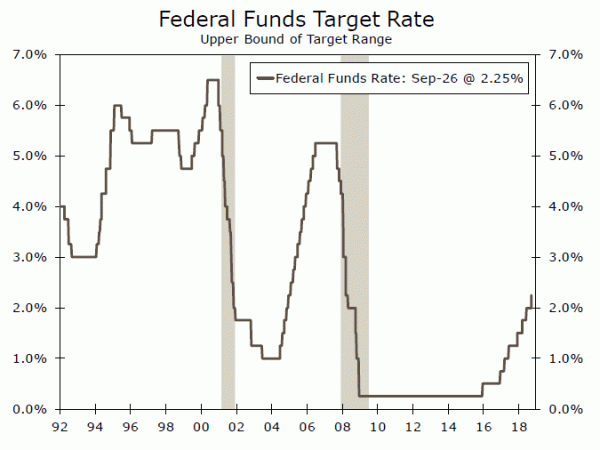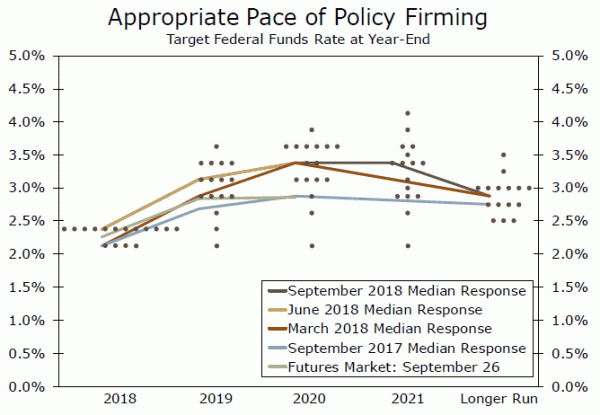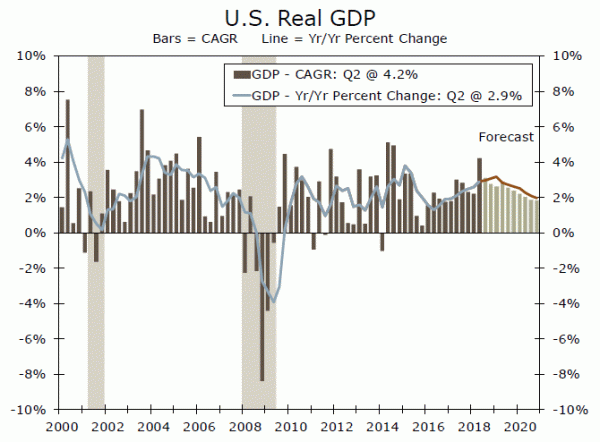As widely expected, the FOMC hiked rates 25 bps today. Interestingly, the committee removed its reference to “accommodative” policy, which suggests that rates may have entered “neutral” territory.
FOMC Removes Reference to “Accommodative” Policy
As widely expected, the Federal Open Market Committee (FOMC) decided by unanimous vote today to raise its target range for the fed funds rate 25 bps. The range now spans 2.00% to 2.25%. Since the Fed began its tightening cycle in late 2015, it has raised its target range 200 bps (top chart).
In our view, the most interesting aspect of the policy statement that the Fed released at the end of today’s meeting was its characterization of the current state of monetary policy. In previous statements, the FOMC said that “the stance of monetary policy remains accommodative.” That is, short-term interest rates were still low enough that they were boosting the pace of economic activity. Notably, the FOMC dropped its reference to accommodative policy in today’s statement.
In recent public announcements, some Fed policymakers have expressed their opinion that the fed funds rate would soon enter “neutral” territory. That is, monetary policy would not be boosting, nor would it yet be restraining, the pace of economic activity. By removing the reference to accommodative policy, the committee is implicitly acknowledging that the fed funds rate has moved into neutral territory.
That is not to say that rates will not rise further from here. The neutral fed funds rate is not precisely measured and its range could be broad. Indeed, the so-called “dot plot” shows that the vast majority of FOMC members believe that another 25 bps rate hike by the end of the year would be appropriate (middle chart). Moreover, the median projection of FOMC members looks for 75 bps of further rate hikes in 2019 and 25 bps of additional tightening in 2020. Our own forecast is more or less in line with the Fed’s projections. That is, we look for another 25 bps of tightening in December and three rate hikes of 25 bps each in 2019, before the Fed remains on hold for roughly a year.
In its statement today, the FOMC said that “economic activity has been rising at a strong rate.” We forecast that growth will generally remain solid in coming quarters, but that it will slow somewhat from the 4.2% annualized rate that was registered in Q2-2018, as fiscal stimulus fades and as previous monetary tightening exerts some headwinds on the economy (bottom chart). Looking into 2020, we believe that growth will slow enough to lead the Fed to reverse itself by cutting rates 25 bps at the end of 2020. Admittedly, the end of 2020 is a long time from now and our visibility two years ahead is undoubtedly cloudy. In the meantime, it seems likely that the FOMC will continue to hike rates at a gradual pace. The end of this tightening cycle has not yet arrived. But by removing its reference to accommodative monetary policy today, the FOMC may be signaling (in the words of Sir Winston Churchill) “the end of the beginning” of the current tightening cycle.















